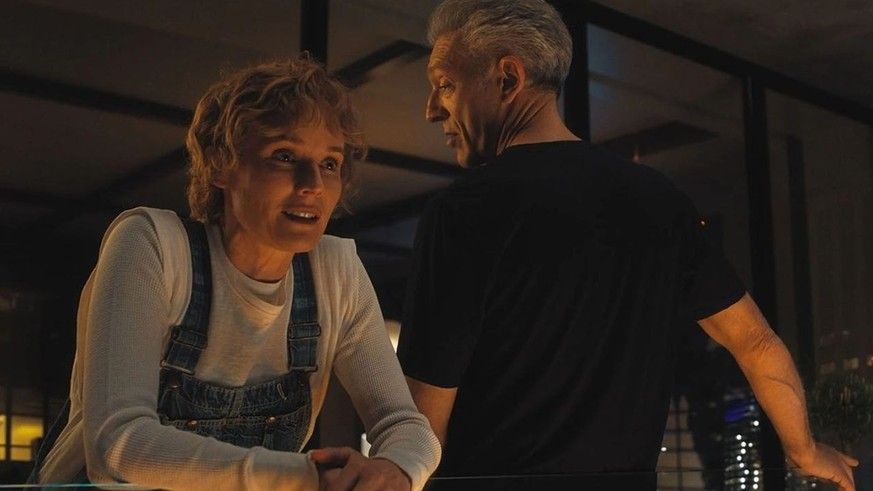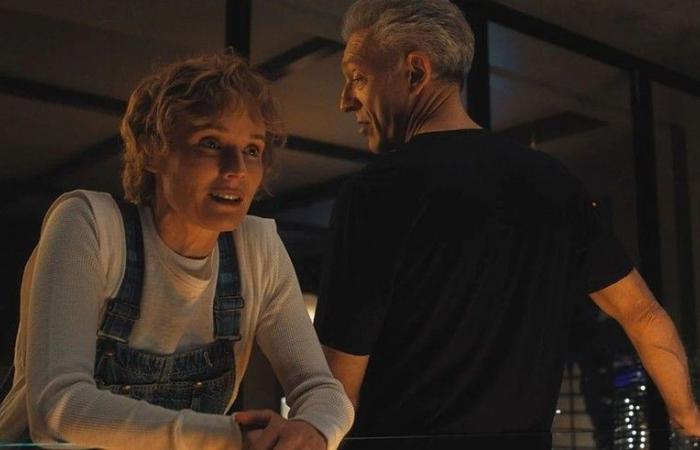
Diane Kruger and Vincent Cassel are playing with the 25th film by David Cronenberg.dr
Simply because director David Cronenberg is at the helm of this new feature film entitled The shroudsand because we will find the formula that made its success.
04.05.2025, 12:0804.05.2025, 12:08
Maxime Parola / the conversation
No more “entertainment”
An article by The Conversation
Director David Cronenberg has been back in theaters since Wednesday, April 30, with a new feature film, The shroudsfeaturing Diane Kruger and Vincent Cassel. Does this 23ᵉ film differ from the rest of his work? This is so far marked by a Recurring narrative diagram. Analyse.
Master of metamorphosis and body drifts, David Cronenberg has sculpted a work as disturbing as they are influencing, redefining the boundaries of horror cinema.
If its filmography is widely known for its thematic coherence and its aesthetic diversity, few authors have nevertheless underlined its amazing narrative homogeneity.
The trailer:
Of the 22 feature films of David Cronenberg so far released, 19 share an almost identical structure (the other three being The Brood, Fast Company and the last Crimes of The Future). Videodrome (1983) is, in this sense, an interesting case, because its structure can serve as a matrix example for all other works in Cronenberg.
The example with Videodrome
In Videodromewe follow the story of Max, director of a pornographic chain. He has a relationship with Nicki, a young woman with whom he experiences new sexuality for him. He also discovered a new program, “Videodrome”, which exposes it without his knowledge of a video signal capable of transforming his body.
Conducting the investigation into this program and his symptoms, he finds himself in the midst of a conflict between two groups: the “new flesh”, led by Professor O’Blivion and his daughter Bianca; And “Videodrome”, led by Barry Convex and his accomplice Harlan.
After multiple twists and turns of his body, Max ends up isolating himself in a wreck where Nicki sends him a message to tell him that he can access a “new flesh” if he accepts to commit suicide, which he does. The film concludes here, but in another version of the script, an additional scene was planned where Max, Bianca and Nicki found themselves in the setting of the “Videodrome” program with multiple changes, to have a new sexual intercourse.
By following the idea of a unique narrative frame at the origin of all Cronenberg films, Each work would then be a variant of this frameintegrating either all of its narrative elements, or only a part. Videodrome presents a particular interest, because it is, in my opinion, the film closest to this original narrative frame.
This frame tells the story of a childless man, engaged in a relationship of seduction at one time or another. He meets a male figure holding knowledge on the body (often a doctor, but not always). This knowledge is symbolically transmitted to him through an intermediary which can be an object, a creature, knowledge, even an idea. This knowledge then modifies the hero’s body, literally in the first third of Cronenberg’s work, or symbolically in the following films.
Using his new body, the hero tries to access a stage of unprecedented evolution where a new type of sexual intercourse would be possible allowing a total fusion.
The situation inevitably turns to vinegar, most often causing the death of the hero or, at least, a deeply tragic end.
We find this same narrative structure at the origin of all the stories of Cronenberg.
For example, in Cosmopolisthe character of Eric sees his symbolic body, embodied by his car, to transform himself from the moment a doctor diagnoses him an asymmetrical prostate. This unbearable imperfection on which the doctor refuses to act causes the character’s moral and physical collapse, until his confrontation with his assassin, who also admits to having an asymmetrical prostate. He thus joined the category of “enemy brothers”, recurrent at Cronenberg.
-The archetypical figure of the knowing as a symbolic father both positive and negative, embodied by the characters of O’Blivion and Convex in Videodromeis also particularly well represented in Scanners. In this 1981 feature film, the doctor who helps the hero turns out to be the crazy scientist who created his illness. He is also the father of the hero and the main antagonist. We see here how the figure of the knowing is split between a protective father (perceived as such by the hero) and a predatory father (perceived as such by the hero’s enemy).
Lacan with Cronenberg
Psychoanalyst Jacques Lacan has proposed several concepts which can be useful to give coherence to the work of Cronenberg.
The quest for fusion in its characters can be compared to “The impossible of sexual intercourse” in Lacan.
The latter explains that there is a universal anxiety due to the impossibility of merge with the other: the mathematical relationship 1+1 never makes 1.
The bodily transformations at Cronenberg are then attempts to bypass this impossible through a new body allowing access to a total enjoyment which would not be limited by any impossible.
Another Lacanian concept can make it possible to better understand these mutations: the symbolic body. This is the part of the body homogeneous to a language of which unity is the signifier. Cronenberg explains for example that in Videodromethe pistol that merges with the hand is the representation on the screen of a play on words: the signifier “handgun” becomes a fist in the film. For Cronenberg, playing on words is like playing on the body. David Roche already said it very well starting from the film Shivers (1975), where he identified the creature as a signifier emerging from the mouth.
If we resume Videodrome With these ideas, the film tells the story of a man whose symbolic body will be transformed by a signifier embodied in the film by the “Videodrome signal”. The transformations will allow him to develop new sexual organs (the fist-arm signifier is assimilated to the signifier phallus) which must allow a success of a sexual intercourse in the sense of Lacan, and thus access the fusion with its partners.
But the impossible is not showable and, for Cronenberg, it seems stronger to leave the spectator in front of a black screen to confront him with his own relationship with anxiety.
We find the same idea very literally at the end of The Fly (1986), where the character tries to physically merge with his pregnant wife, but fails in extremis.
Return of the Primitive Horde
If we remain in the field of Lacanian psychoanalysis, we can interpret the narrative frame common to a kind of remake of the Freudian myth of the primitive horde. Freud says that, at the origin of the times, there was a father who had all the women, because he had a particular signifier: the phallus.
The father’s sons ended up getting fed up. They killed him, then ate him to appropriate the phallus. But so that the father’s hegemony does not happen again and everyone submits to a common law, They erected a statue on his behalf. Lacan returns to this myth by stressing that, Behind the alleged power of the Father is above all the belief of the sons in this power.
This question of belief is predominant in the characters of Cronenberg who seem to join with a great conviction to the father’s knowledge, against all consequences.
These throw themselves to be lost in their quest for fusion up to systematically tragic purposes.
The only possible outcome for the Cronenberg hero seems to be the renunciation of fusion and, therefore, to the total enjoyment it could allow. But only one will make this choice and will thus avoid a tragic end. This is Joey/Tom in A History of Violence (2005) who chooses to give up the all enjoyment of “Joey” to symbolically washing his hands in order to find the life of “Tom”. We can note that he is also the only character of Cronenberg to have children (The Brood (1979) is, for me, apart). Cronenberg seems to believe that Only paternity can compete with these characters the fantasy of total enjoyment.
This article was initially published on The Conversation. Watson changed the title and the subtitles. Click here to read the original article.
Are we changing the subject?
The actors of our favorite series, have they changed?
1 / 10
The actors of our favorite series, have they changed?
The canvas cracks for mini-beyoncé
Cinema fan? These articles could interest you!
Show all articles










